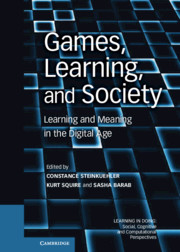Book contents
- Frontmatter
- Contents
- Contributors
- Series Foreword
- Foreword
- Acknowledgments
- Section I Games as Designed Experience
- 1 Introduction to Section I
- 2 Designed Cultures
- 3 Theme Is Not Meaning
- 4 Our Cheatin’ Hearts
- 5 Playing the Odds
- 6 Nurturing Lateral Leaps in Game Design
- 7 Uncharted 2: Among Thieves – How to Become a Hero
- 8 Interview with Harmonix
- 9 Yomi
- Section II Games as Emergent Culture
- Section III Games as Twenty-First-Century Curriculum
- Index
- References
2 - Designed Cultures
Published online by Cambridge University Press: 05 August 2012
- Frontmatter
- Contents
- Contributors
- Series Foreword
- Foreword
- Acknowledgments
- Section I Games as Designed Experience
- 1 Introduction to Section I
- 2 Designed Cultures
- 3 Theme Is Not Meaning
- 4 Our Cheatin’ Hearts
- 5 Playing the Odds
- 6 Nurturing Lateral Leaps in Game Design
- 7 Uncharted 2: Among Thieves – How to Become a Hero
- 8 Interview with Harmonix
- 9 Yomi
- Section II Games as Emergent Culture
- Section III Games as Twenty-First-Century Curriculum
- Index
- References
Summary
As educators investigate the power of games for learning, much attention has been paid to the learning principles underlying video games (Gee, 2003/2007), their design features (also called formal abstract design tools; Church, 2005), such as the use of narrative for creating investment (Davidson, 2009), or rhythmic immersion (see Squire, 2011). An understanding of these design tools and patterns is critically important to enable understanding of learning at the human-computer level. Indeed, much of educators’ interest in games lies in understanding their design so as to better understand cognition as a materially situated, digitally mediated phenomenon (see Shaffer & Clinton, 2006; Lemke, 2005), as well as how to design more compelling, effective learning materials ranging from multiuser virtual environments (MUVEs) to digital textbooks (Squire et al., 2003).
Consistent with the sociocultural approach, it is equally important for researchers and theorists to understand the socially situated nature of game play. Social structures such as families, guilds, informal gaming networks, and broader cultural notions of play further mediate game play and thus learning. For example, familial rules (such as the length of time that a child is permitted to play) make some forms of gaming practice available while prohibiting others; if a child is permitted limited gaming time, it is unlikely that he or she will have opportunities to engage in sophisticated practices such as modding. Within multiplayer games, guilds function as a remediating force, pushing particular values for how games ought to be played as instantiated through formal and informal participation structures (such as dragon kill point [DKP] systems, looting rules, and rules for membership). Such structures may be on par with the software itself when constituting the game-play experience in such contexts (Squire & Steinkuehler, 2005).
- Type
- Chapter
- Information
- Games, Learning, and SocietyLearning and Meaning in the Digital Age, pp. 10 - 31Publisher: Cambridge University PressPrint publication year: 2012
References
- 4
- Cited by



